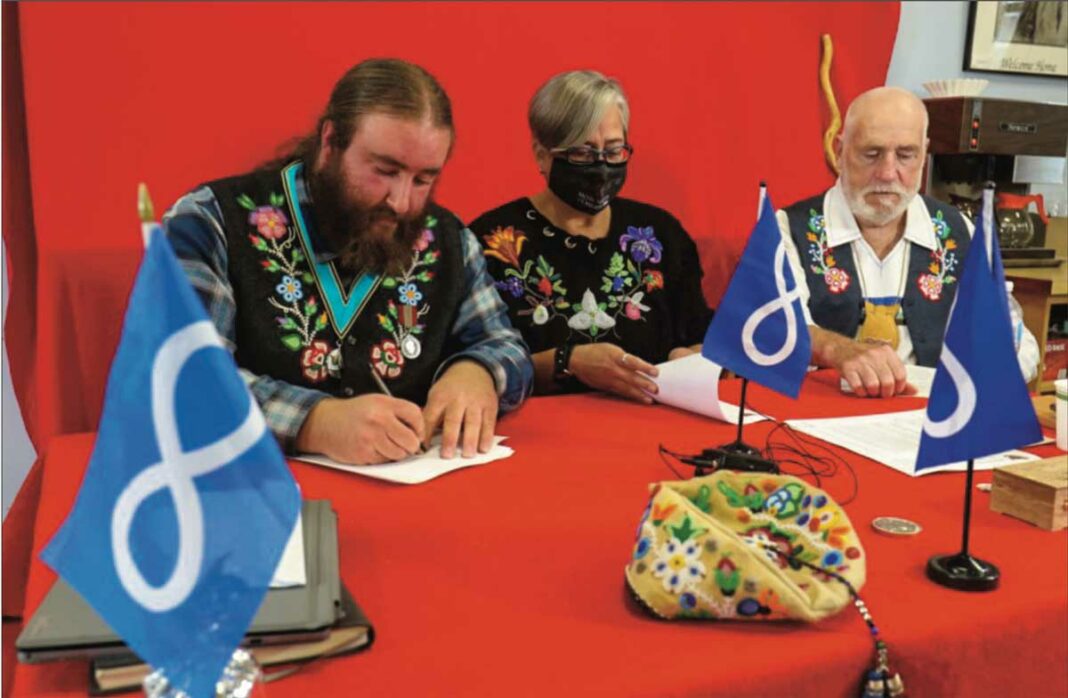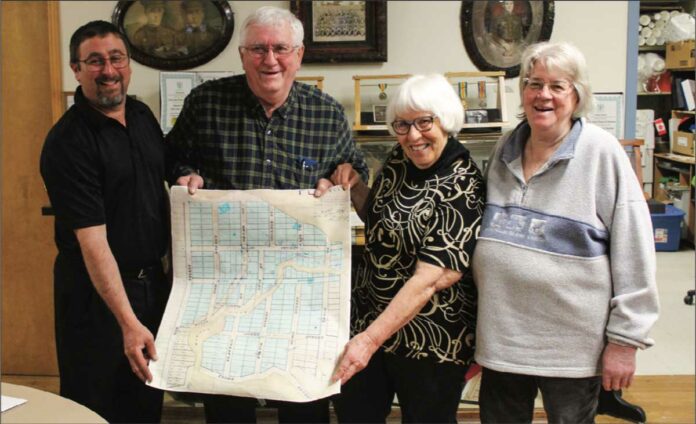ONTARIO—Ontario Regional Chief Glen Hare says he supports the Robinson-Huron Waawiindamaagewin (RHW) in release of a new report that calls upon Canada to immediately cease all action relating to the Metis government recognition and self-government implementation agreement.
Regional Chief Hare says the study serves to support the RHW (which includes all First Nations on Manitoulin Island) to occupy and exercise authority and jurisdiction over its communities, economies and ways of life with their territory since time immemorial. However, a Metis Nation of Ontario (MNO) Regional Councillor for the Huron-Superior Regional Metis Community says three levels of courts in Ontario and the Supreme Court have confirmed that the Huron-Superior Regional Metis community has been confirmed as existing as a Metis community with constitutionally protected rights.
“I support Robinson-Huron Waawiindamaagewin (RHW) and its 21 member First Nations in their release of ‘An Exploratory Study of the Metis Nation of Ontario’s Historic Metis Communities in Robinson-Huron Treaty Territory’,” said Regional Chief Hare.
The report prepared by Dr. Darryl Leroux and Dr. Celeste Pedri-Spade examines four of the “so-called historic Metis communities within the Robinson-Huron Treaty Territory: Georgian Bay, Killarney, Mattawa and Sault Ste. Marie,” said Regional Chief Hare.
A press release explains, “RHW challenges the historical existence of distinct Metis communities in the Robinson-Huron Treaty territory and, as such, commissioned the study. The report uncovered how the MNO’s poor research practices actively omitted historical data that calls into question their interpretation of ‘verified Metis family lines.’ For example, the MNO has identified individuals as Metis even when individuals are consistently recorded as First Nation, which contradicts their stated approach. The report has documented hundreds of times that the MNO engages in such misleading practices, proving the fatal flaws in creating Metis communities in Robinson-Huron Treaty territory.”
On February 24, the Government of Canada and the MNO signed the Metis Government Recognition and Self-Government Implementation Agreement.
“The Anishinabek have not given the Metis any rights and do not recognize any MNO communities or any rights that the Crown may give them. It is contrary to our understanding of who can give those rights which is the Anishinabek; and not the Crown or government,” said Ogimaa-kwe Linda Debassige of M’Chigeeng First Nation.
“The research utilized by MNO for the McLeod-Riel Metis family line claims an RHW Anishinaabe family as a basis for Metis membership,” said Shawanaga First Nation Chief Adam Pawis. “All the evidence surrounding this family points to their identity as Anishinaabe not Metis.”
“The settler government of Canada and the MNO are attempting to push legislation through which will culminate with the signing of a ‘modern-day treaty’ that will encroach upon the rights of RHW and its citizens,” said Batchewana Chief Dean Sayers. “This fast-tracked push is an affront to the unextinguished rights and jurisdictions of RHW. We cannot sit idly by while the settler government continues to discuss and deal with groups claiming Indigenous ancestry without our consent.”
“The MNO currently has 31,000 members, a 55 percent increase over 2020,” Chief Sayers continued. “Most of its members are tied to one of the Metis communities in our territory, further impacting the rights of RHW communities and their members. Aside from the findings in Drs. Pedri-Spade and Leroux’s report, by the MNO’s standards, over 5,000 of its members do not meet their membership criteria. RHW disagrees that the settler government of Canada can enter into these agreements, legislation and treaties with a group that has not demonstrated through sound research the legal existence of distinct Metis communities in our territory.”
“Canada is seeking to delegate rights to the Metis when they are, in fact, in receipt of a delegated authority to be on RHW lands,” stated Nipissing First Nation Chief Scott McLeod. “Delegating rights to the MNO with dubious ancestral claims violates their Treaty promise. They do not have the right to delegate any rights to the MNO. That contemplation should come from RHW.”
However, Mitch Case, MNO Regional Councillor of the Huron-Superior Regional Metis Community wrote, “With the statements made this week from the (RHW) and a few chiefs, I want to respond with the facts. The current frenzy being advanced by some denies the very existence of my Metis community, a community with constitutionally protected rights confirmed by the Supreme Court of Canada, and the other Metis communities in Ontario. It is appalling and unconscionable.
“I am elected to lead my Metis community in the Huron-Superior region,” said Councillor Case. “I am proud of my history from this well-known and well-documented Metis community. I was raised by this Metis community.”
“Let me be clear: we are not Anishinaabe,” said Councillor Case. “Nor are we anyone’s leftovers or subordinates. We are also no one’s poor cousins, beholden or subservient to anyone else’s recognition or acceptance. I reject any suggestion that we need anyone else’s permission to be a people, community, or to be proud of who we are. Our existence is rooted in our own culture, identify, collective consciousness, assertions, resilience, and inherent rights.”
“In many ways these attacks only serve to make us stronger and more resilient. Look at we did in 1849-1850 when we joined, as ‘half-breeds,’ with our Anishinaabe kin to push back on Canada’s incursion on our shared territory as a part of the Mica Bay Uprising,” continued Councillor Case.
“Look at what Ontario’s denial of our very existence in the 1990s did as well,” the councillor continued. “It led us to advancing the historic Powley case based on the strength and resilience of the Powley family and the support of our community and the (MNO) all the way to the Supreme Court of Canada.”
Councillor Case explained, “three levels of courts in Ontario and the Supreme Court were unanimous in confirming our existence as a Metis community with constitutionally protected rights. The evidence before the courts was overwhelming. Not one of the 14 judges we appeared before in that 10-year litigation battle disagreed with the undeniable fact that there was a Metis community in this region of Ontario. We will never go back to those days, and these new denials will only serve to strengthen our resolve.”
Councillor Case said, “It is also worth noting that it is a bit ironic that the (RHW), who have also valiantly turned to the courts to rightly have the Robinson-Huron Treaty respected, and who unquestionably accept and rely on the court decisions in the historic Restoule litigation to now negotiate with the Crown, are now turning around and attempting to ignore similar court decisions that affirm co-existing Metis rights in the Robinson-Huron Treaty territory.”
“These chiefs are trying to deny our ability to negotiate with the Crown, about how we have chosen to identify our citizens, govern ourselves and protect our children, families and communities for generations to come. I find this logic difficult to follow,” continued Councillor Case.
“I also want to bring our Metis history to the table,” he added. “Others may choose to ignore it for political soundbites, but the facts are there for all who want to see. From the late 1700s, there was a distinct Metis population that emerged in the Upper Great Lakes region, anchored on either end by Sault Ste. Marie and Penetanguishene. There are hundreds of documents which acknowledge our distinct community by either First Nations, outsiders, the Crown or in our own words.”
Councillor Case explained, “In the 1970s and 1980s, our Metis communities here in Ontario worked hard with other Metis to get “Metis” included in section 35 of the Constitution Act, 1982. After that victory, we knew we needed to create a Metis-specific government for our citizens and our communities. We did just that in 1993 with the creation of the MNO. In the 1990s, we participated in the negotiations of the Metis Nation Accord as a part of the Charlottetown Accord, which was ultimately rejected by Canadians.”
Councillor Case stated, “this year is the 20th anniversary of our victory in the Powley Decision. Powley is 100 percent clear: there was, and is, a Metis community in Sault Ste. Marie that exists within the Robinson-Huron Treaty territory. It was here before that treaty was signed in 1850. It continues to be here today, and it has rights that co-exist with treaty rights. Period. And our rights are rooted in our existence as a people and distinct community, not as derivatives of our First Nations relations who require their consent.”
Councillor Case said that in 2004, the MNO and the Chiefs of Ontario signed a political protocol which stated in part, “to affirm mutual respect, recognition and support for the respective rights, interest and aspirations of First Nations and the Metis Nation within Ontario.” That same year, the MNO and the Anishinabek Nation entered into a similar agreement with MNO. It was said to be a nation-to-nation agreement.





